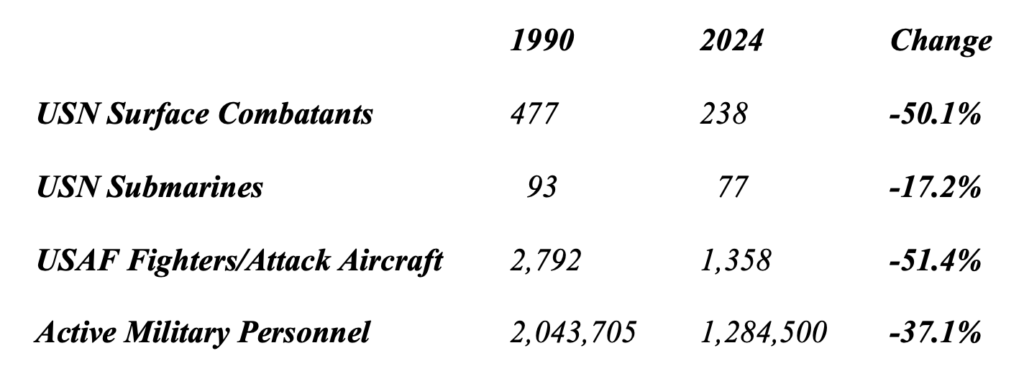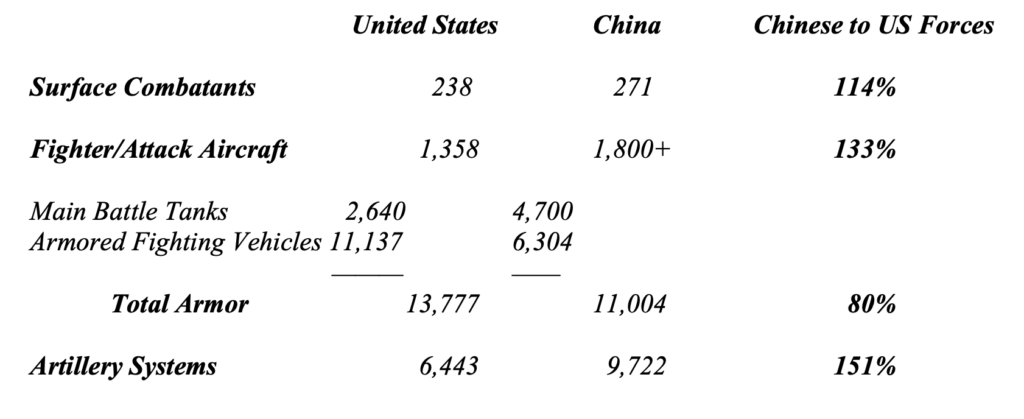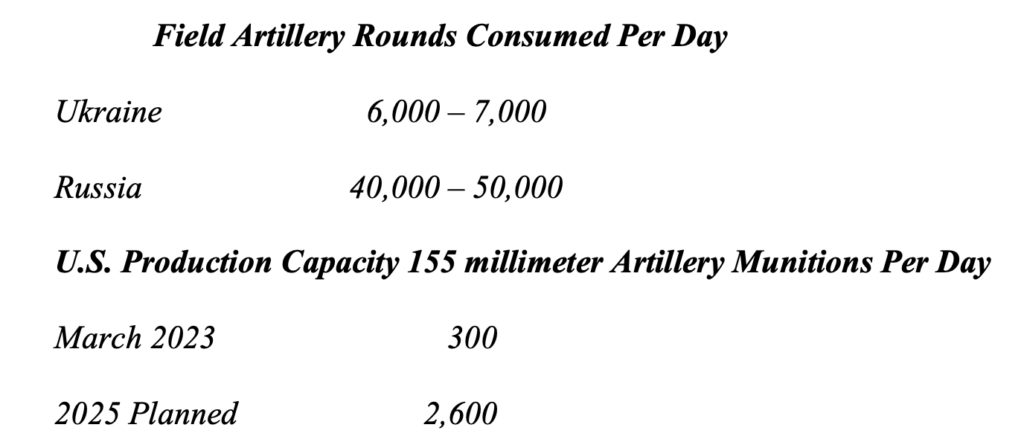The Great Game of Power: Industrial Policy, National Security, & Military Might
Views From the Stream
The Monthly Letter covers two topics this month. First, we focus on the rise of National Security and its impact on Industrial Policy. As a National Security lens becomes attached to all items in the economy, significant change lies ahead. Clearly, a variety of items where the US outsourced production to other countries will need to relocate back to U.S. shores. And, with the potential for a war against ,what Washington, D.C calls, a “Peer Competitor”, the need for a strong Defense Industrial Base will become a priority. Combined, these will form a National Strategy around Industrial Policy. And this Industrial Policy will create a significant impact on both Economic Growth and how the economy functions. In many ways, the economy will come to resemble the environment that existed during the 1980s and 1990s, when all of these stood intertwined for the country. Second, as always, we close with brief comments of interest to our readers on a variety of current topics relevant to the economy and the markets.
The Great Game of Power:
Industrial Policy, National Security, & Military Might
“Igitur qui desiderat pacem, praeparet bellum.”
(Therefore let him who desires peace prepare for war.)
De Re Militari (Epitoma Rei Militaris)
By Publius Flagius Vegetius Renatus
4th Century A.D.
“But having attained to a certain grade of development by means of free trade, the great monarchies perceived that the highest degree of civilisation, power, and wealth can only be attained by a combination of manufactures and commerce with agriculture. They perceived that their newly established native manufactures could never hope to succeed in free competition with the old and long-established manufactures of foreigners; that their native fisheries and native mercantile marine, the foundations of their naval power, could never make successful progress without special privileges; and that the spirit of enterprise of their native merchants would always be kept down by the overwhelming reserves of capital, the greater experience and sagacity of the foreigners. Hence they sought, by a system of restrictions, privileges, and encouragements, to transplant on to their native soil the wealth, the talents, and the spirit of enterprise of the foreigners.”
The National System of Political Economy
Chapter X: The Teachings of History
By Friedrich List, 1841
For those who have watched China’s rise over the past 25 years, there exists a simple explanation for its move to the forefront of countries globally. With the entry into the global trading order under the WTO in 2000, the country created a strategic policy focused on investment in both infrastructure and industrial capacity to grow its global market share. The country applied this with a single-minded focus as part of its 100 Year March to undo its 100 Year Humiliation. China’s Gross Fixed Capital Formation (GFCF) exploded upward, compounding at 12% – 20% annually from 1992 – 2015 with no pauses:

In other words, every 6 years China’s investment doubled, an unprecedented rate even for an emerging economy. As a result of this massive growth, the country’s capital investment exploded from just 30% of GDP in 1992 to almost 45% in 2012:

As this investment grew, it allowed China to come to dominate numerous industries globally as its companies did not have to earn real returns on capital as its foreign competitors did and the Chinese government paid for much of the Industrial Capacity, enabling its companies to sell products well below foreign competitors. In addition, in industries where capacity should shut, due to the plants running at a cash loss, the government continually propped up companies such that they could outlast their foreign competitors who owned capacity both inside the country and outside of it. Lastly, as the domestic companies grew, the government handicapped their foreign competitors, such that they could not compete in the domestic market, squeezing them out.
In many ways, China adopted the Industrial Policy advocated by Friedrich List in his great 1840s opus, The National System of Political Economy. This work became the bedrock on which Prussia grew into a Great Power, rivaling both Great Britain and France, using its industrial might to create military power. Leveraging this newfound military power, Prussia created the German Empire in 1871. And then, given its rise, it went on to demand “Our Place in the Sun” from the other European powers both in Europe and across the globe. If we fast forward to today, China appears to have followed the same script as Prussia. It first built its industrial capacity, then used this to create a military that rivaled that of the Great Powers of today. In doing so, it seeks to become the dominant country in the world, able to dictate policy to other countries and to leverage its military might to project power to foster its continued growth and increasing dominance. In other words, it wants “Our Place in the Sun” much as the German Empire did in the late 1800s. (Please see: Germany 1897 and Our Place In The Sun: Parallels with the Current and Future Rise of Chinese Militarism, published April, 2013)
For the rest of the world, this creates a geopolitical challenge, especially for the United States. The whole assumption behind allowing China into the global trading system now stands on its head. The original goal, to open China’s markets to the rest of the world, appears as successful as during the late 1700s and early 1800s, prior to the Opium War. In other words, the policy turned out a colossal failure as China utilized this opening of Western markets to drive its rise. Second, due to the implementation of List’s theories utilizing overtly mercantilist policies, China now possesses the largest industrial base in the world and continues to accelerate its military expansion. The country continues to follow most Great Power playbooks, whereby it builds forward military bases across the world to support its global ambitions. This merely replicates what countries such as Great Britain did during the 1800s or the United States after World War II.
With a rising Great Power that stands opposed to Western interests, the US must address many years of underinvestment in its economy, especially in Industrial Capacity. Industrial output stopped growing in 2000 with the entry of China into the WTO, whereby it unleashed its industrial capacity on the world.

As a result, US Manufacturing to GDP shrank massively from 2000 to 2020 as the US sourced more and more of the goods it consumed from outside the country:

With China continuing to build massive amounts of capacity to maintain its economic growth, despite an inability to absorb this capacity domestically, it must unleash massive quantities of surplus goods onto the global economy. Unlike in the early 2000s, when China’s entry into the system came with open arms and the hope it would open its markets, tariffs and trade restrictions continue to greet this latest onslaught, with much of the rest of the globe determined to limit the impact on their domestic markets. (Please see The Great Game of Power: China for Chinese Companies Only, Again, The Global Market Share Grab, & The Rise of the U.S. National Interest published October 31, 2023 for more details.)
In addition to underinvesting in its industrial capacity and not protecting it from foreign competition, the US massively underinvested in its National Security starting in the early 1990s. With the “end” of the Cold War and a much lower threat from the U.S.S.R., the United States allowed its Defense spending to fall to reap a “Peace Dividend” in the form of a reallocation of spending away from Defense:

Today, the U.S. spends just 3.6% of its GDP on National Defense. This compares to a minimum of 6.1% during the Cold War and 10% or more during actual wars. If the US were just to return to the low spending levels reached under President Carter in 1979, America would need to spend 2.5% of GDP more on National Defense or an additional $684 billion. To put this into perspective, the US spent $995 billion in Fiscal 2023 (year ended September) on Defense. To return to the levels under President Reagan during the defense buildup that won the Cold War, the US would need to double its National Defense spending. This massive underspending over the past 35 years can be easily observed in the size of the armaments the United States possesses as well in the number of Active Military Personnel:

As the above table makes clear, US military hardware, as well as the size of the military forces stand significantly below where they stood in 1990. This attrition occurred slowly over time as Congress continued to reallocate funds to non-Defense areas that took higher priority. That meant actual funds allocated to the armed forces stood well below replacement levels. This led to a slow, but sure shrinkage in the force structure.
Today, the United States faces a China that now possesses a larger Navy, with 271 total vessels, outsizing the US Navy by almost 20%. With a more concentrated geographic position, the PLA Navy Surface Force can bring many more ships to bear in a confrontation than the US. The PLA Air Force possesses almost 1800 fighter aircraft, 30% more than the US Air Force. Similar disparities exist elsewhere between the other portions of the two military forces. With Congress noting this issue, real spending on Defense Procurement and RDT&E started to rise under the Trump Administration. The following chart shows how the US finally began to respond to China’s military buildup:

However, despite the increase in spending by Congress recently, Defense spending on Equipment and Space remains far below levels seen in the 1980s relative to the size of the economy. This represents the last time the US needed to stand in a position to fend off a peer Great Power and to possess the industrial capacity to sustain its wartime capabilities in a prolonged conflict:

With 25+ years of underspending relative to the economy, the United States underspent on military equipment by almost $9 trillion in today’s dollars over this time frame. (This assumes that 35% of the military budget goes to Procurement and RDT&E as well as ~$1 trillion in total Defense spending annually.) The impact of this massive underinvestment can be seen in multiple ways. The following table compares U.S. armaments and vehicles to China:

Center for Strategic & International Studies.
Second, the above massive underinvestment coupled with 20 years of outsourcing of its manufacturing capacity to other countries created large strategic vulnerabilities in U.S. supply chains. The United States currently possesses significant dependence on Chinese parts and components in Electronics, Industrial Equipment, Materials & Chemicals, and Transportation Equipment. Critically, according to a report from Govini, “more than 40% of the semiconductors that sustain DOD weapons systems and infrastructure depend on Chinese suppliers.” Third, the choice to not invest in surge capacity needed to sustain wartime consumption of munitions shows clearly in the following data from the Ukraine-Russia War:

As the above table makes clear, U.S. capacity to sustain a war stands woefully inadequate. And the ability to supply front line soldiers with the materials they need stands in doubt. Fourth, the U.S. ability to replace various hardware that would end up destroyed in a war creates a further strategic vulnerability. For example, U.S. shipyard capacity stands almost non-existent at less than 1% of global capacity. China, in comparison, possesses 35% of global capacity. And there exists another 35% in South Korea and 16% in Japan. Given the United States position as a naval power with two major oceans on either side and the requirement to maintain freedom of navigation in both these oceans, not having the ability to churn out ships as needed for both domestic and global needs undercuts the U.S. ability to support its National Security and trade.
With China now possessing 4 of the 10 largest defense companies in the world and stockpiling munitions and parts at a rapid rate to prepare for war, the United States faces a situation similar to what existed during the late 1930s as war started to break out around the globe. To meet its National Security needs today, the United States will need to address these issues quickly and aggressively. The country will need to put together a multi-pronged approach to over 20 years of policy focused on a Peace Dividend. This strategy should include at least the following pieces that the U.S. used successfully prior to 2000:
- Presidential Body with Authority – Presidents Roosevelt, Truman, Eisenhower, and Reagan all created Executive Boards and Commissions with authority to plan, to coordinate, to oversee, and to procure necessary armaments. This included the authority to stand up production and create strategic stockpiles of raw materials and components.
- Increase Surge Capacity – As the above data makes clear, the U.S. possesses insufficient capacity to sustain a war beyond a few weeks. The DOD must invest in sufficient capacity to sustain the U.S. if it should fight a war similar in duration to the Korean War or the Vietnam War.
- Strategic Stockpiles – The US must create strategic stockpiles to carry it through the early stages in a war that provide a buffer until it can create additional capacity. Else, the armed forces will literally run out of munitions in the critical early stages of a war.
- Address Strategic Supply Chain Vulnerabilities – Given the push by China to remove foreign components from its supply chains to prepare for the cutoff of foreign supplies, the U.S. must remove all Chinese components from its supply chains, especially those related to the defense industrial base. It must support and, if necessary, underwrite the needed capacity to supply the nation’s needs.
- Create Economic Incentives for New Defense Entrants – Defense contracting stands complicated and difficult with a labyrinthine set of regulations. These regulations create costly impediments to new entrants with new technology. Instead, they need a pathway that cuts through the red tape and makes it easy for commercially oriented companies to adapt their technologies to defense related goods. Utilizing off the shelf technology will cut costs, enable scaling, and accelerate time to market.
- Create a Defense Intelligence Board – This Board would detail the entire defense industrial base of China including supply chains, factories, logistics centers, and key personnel who run each network. During the Cold War, this Board enabled the U.S. to understand the capabilities of the U.S.S.R. and its strategic vulnerabilities.
All of these actions could create lower costs and higher production for the U.S. than currently exists enabling the country to meet its needs. While much of this production should locate within the Continental U.S., the portion that consists of standard industrial parts that require high labor input could find themselves in Mexico. Mexican labor costs per hour stand at 65% of China’s labor costs. Thus, moving this industrial production from China to Mexico should cut out a significant amount of labor costs as well as eliminate strategic vulnerabilities. In addition, the cost to truck the components or to use rail to ship the goods from Mexico to the United States, stands a fraction of moving the same goods across the ocean from China and then putting them on a truck or railcar to their final destination.
Given China’s goal of reunification with Taiwan, coupled with President Xi setting a date of 2027 for completion of China’s military preparation to take the island by force if necessary, the United States faces some tough choices. It must move quickly to put in place the Industrial Policy necessary to underpin its National Security. It must allocate significant resources behind this effort. And it must remember the strategy that won multiple wars over the past 100 years, first articulated by Friedrich List in the 1800s, that Industrial Might equals Military Might. With a potential major war rushing towards it and the country unprepared, America must replicate the late 1930s actions that successfully turned the country upside down to meet these types of challenges in the past. And meeting these challenges all started with a President that recognized the risk to America and faced it square on. It will not come cost free. But it will enable the country to defend democracy around the globe once more. President Franklin D. Roosevelt put this most succinctly in his famous December 29, 1940 Fireside Chat, a year before Pearl Harbor and the official entry of the United States into World War II:
The history of recent years proves that the shootings and the chains and the concentration camps are not simply the transient tools but the very altars of modern dictatorships. They may talk of a “new order” in the world, but what they have in mind is only a revival of the oldest and the worst tyranny. In that there is no liberty, no religion, no hope.
The proposed “new order” is the very opposite of a United States of Europe or a United States of Asia. It is not a Government based upon the consent of the governed. It is not a union of ordinary, self-respecting men and women to protect themselves and their freedom and their dignity from oppression. It is an unholy alliance of power and pelf to dominate and enslave the human race.
…
But all our present efforts are not enough. We must have more ships, more guns, more planes—more of everything. And this can be accomplished only if we discard the notion of “business as usual.” This job cannot be done merely by superimposing on the existing productive facilities the added requirements of the nation for defense.
Our defense efforts must not be blocked by those who fear the future consequences of surplus plant capacity. The possible consequences of failure of our defense efforts now are much more to be feared.
And after the present needs of our defenses are past, a proper handling of the country’s peace-time needs will require all of the new productive capacity—if not still more.
No pessimistic policy about the future of America shall delay the immediate expansion of those industries essential to defense. We need them.
I want to make it clear that it is the purpose of the nation to build now with all possible speed every machine, every arsenal, every factory that we need to manufacture our defense material. We have the men- the skill- the wealth- and above all, the will.
I am confident that if and when production of consumer or luxury goods in certain industries requires the use of machines and raw materials that are essential for defense purposes, then such production must yield, and will gladly yield, to our primary and compelling purpose.
So, I appeal to the owners of plants—to the managers—to the workers— to our own Government employees—to put every ounce of effort into producing these munitions swiftly and without stint. With this appeal I give you the pledge that all of us who are officers of your Government will devote ourselves to the same whole-hearted extent to the great task that lies ahead.
As planes and ships and guns and shells are produced, your Government, with its defense experts, can then determine how best to use them to defend this hemisphere. The decision as to how much shall be sent abroad and how much shall remain at home must be made on the basis of our over-all military necessities.
We must be the great arsenal of democracy. For us this is an emergency as serious as war itself. We must apply ourselves to our task with the same resolution, the same sense of urgency, the same spirit of patriotism and sacrifice as we would show were we at war.
For the U.S., given war in Europe and war in the Middle East, coupled with the true possibility of war in Asia, there exists the real potential of a third World War. To meet this challenge, as President Roosevelt would state, America must once again become the great Arsenal of Democracy, one that upholds free nations around the world and comes to their aid. As former generations know, freedom comes with a price. Else, the tyrannies that would seek to eradicate it from the world would come to cover the globe in darkness. For the United States of America, by rising once more to face the challenges of the present and therefore moving to safeguard the possibilities of the future, it will affirm the country’s commitment to the freedoms on which it founded itself, for both Americans and all others around the world. And, in doing so, it will echo the famous words of its founding document:
“We hold these truths to be self-evident, that all men are endowed by their Creator with certain unalienable rights, that among these are Life, Liberty, and the pursuit of happiness. That to secure these rights, Governments are instituted among Men, deriving their just powers from the consent of the governed. That whenever any Form of Government becomes destructive of these ends, it is the Right of the People to alter or to abolish it, and to institute new Government, laying its foundation on such principles and organizing its powers in such form, as to them shall seem most likely to effect their Safety and Happiness.
…
We, therefore, the Representatives of the united States of America, in General Congress, Assembled, appealing to the Supreme Judge of the world for the rectitude of our intentions, do, in the Name, and by Authority of the good People of these Colonies, solemnly publish and declare, That these United Colonies are, and of Right ought to be Free and Independent States; that they are Absolved from all Allegiance to the British Crown, and that all political connection between them and the State of Great Britain, is and ought to be totally dissolved; and that as Free and Independent States, they have full Power to levy War, conclude Peace, contract Alliances, establish Commerce, and to do all other Acts and Things which Independent States may of right do. And for the support of this Declaration, with a firm reliance on the protection of divine Providence, we mutually pledge to each other our Lives, our Fortunes, and our sacred Honor.”
Declaration of Independence
In Congress
July 4, 1776
A Postal Stamp, What Downturn?, and Less Glitter
Finally, we close with brief comments on A Postal Stamp, What Downturn?, and Less Glitter. First, the U.S. Postal Service just announced another rise in rates to $0.73 for a first-class letter stamp, effective as of July 14, 2024. This compares to January, 2019 when the rate stood at just $0.55. This 32.7% increase, or 5.3% compound annual increase, confirms most Americans view of Inflation while leaving a Postal Stamp on it. Second, Truck orders rebounded strongly in Q1, growing 17% year-over-year. This puts the industry on track for production to fall less than 5% in 2024 prior to expected large orders in 2025 and 2026 ahead of the next emissions rule change in 2027. For industry participants, it is What Downturn? And Third, diamond prices fell significantly in 2023, dropping 15% – 20% and are down almost 25% from their peak in the first half of 2022. In addition, they continue to lose share to synthetic diamonds, which now make up 20% of the global market. While industry participants expect some bounce in the second half of the year as global destocking ends, it appears, for now, Less Glitter for the industry.
In Closing
Should you have any questions on how the above issues or the items discussed in our accompanying cover letter impact your family’s financial position or your business’s future as well as the potential actions you could take in response, please do not hesitate to contact us. We welcome the opportunity to discuss this with you.
Yours Truly,

Paul L. Sloate
Chief Executive Officer

